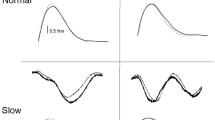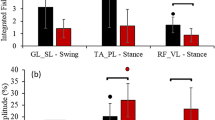Abstract
Although there is some evidence showing that neural coupling plays an important role in regulating coordination between the upper and lower limbs during walking, it is unclear how tightly the upper and lower limbs are linked during rhythmic movements in humans. The present study was conducted to investigate how coupling of both limbs is coordinated during independent rhythmic movement of the upper and lower limbs. Ten subjects performed simultaneous arm and leg cycling (AL cycling) at their preferred cadences without feedback for 10 s, and then were asked to voluntarily change the cadence (increase, decrease, or stop) of arm or leg cycling. Leg cycling cadence was not affected by voluntary changes in arm cadence. By contrast, arm cycling cadence was significantly altered when leg cycling cadence was changed. These results suggest the existence of a predominant lumbocervical influence of leg cycling on arm cycling during AL cycling.

Similar content being viewed by others
References
Armstrong DM (1988) The supraspinal control of mammalian locomotion. J Physiol 405:1–37
Calancie B, Needham-Shropshire B, Jacobs P, Willer K, Zych G, Green BA (1994) Involuntary stepping after chronic spinal cord injury. Evidence for a central rhythm generator for locomotion in man. Brain 117:1143–1159
Dietz V (2002) Do human biceps use quadrupedal coordination? Trends Neurosci 25:462–467
Dietz V, Fouad K, Bastiaanse CM (2001) Neuronal coordination of arm and leg movements during human locomotion. Eur J Neurosci 14:1906–1914
Dimitrijevic MR, Gerasimenko Y, Pinter MM (1998) Evidence for a spinal central pattern generator in humans. Ann N Y Acad Sci 860:360–376
Duysens J, Van de Crommert HW (1998) Neural control of locomotion; part 1: the central pattern generator from cats to humans. Gait Posture 7:131–141
Frigon A, Collins DF, Zehr EP (2004) Effect of rhythmic arm movement on reflexes in the legs: modulation of soleus H-reflexes and somatosensory conditioning. J Neurophysiol 91:1516–1523
Grillner S (1981) Control of locomotion in bipeds, tetrapods, and fish. In: Brookhart JM, Mountcastle VB (eds) Handbook of physiology—the nervous system II. American Physiological Society, Bethesda, pp 1179–1236
Haridas C, Zehr EP (2003) Coordinated interlimb compensatory responses to electrical stimulation of cutaneous nerves in the hand and foot during walking. J Neurophysiol 90:2850–2861
Huang HJ, Ferris DP (2004) Neural coupling between upper and lower limbs during recumbent stepping. J Appl Physiol 97:1299–1308
Juvin L, Simmers J, Morin D (2005) Propriospinal circuitry underlying interlimb coordination in mammalian quadrupedal locomotion. J Neurosci 22:6025–6035
McCrea DA (2001) Spinal circuitry of sensorimotor control of locomotion. J Physiol 533:41–50
Miller S, Van der Burg J, Van der Mechè FGA (1975) Coordination of movements of the hindlimbs and forelimbs in different forms of locomotion in normal and decerebrate cats. Brain Res 91:217–237
Miller S, Ruit JB, Van der Meché FGA (1977) Reversal of sign long spinal reflexes dependent on the phase of the step cycle in the high decerebrate cat. Brain Res 128:447–459
Rossignol S (1996) Neural control of stereotypic limb movements. In: Rowell L, Sheperd JT (eds) Handbook of physiology. Exercise: regulation and integration of multiple systems. American Physiological Society, New York, sect 12, pp 173–216
Sakamoto M, Endoh T, Nakajima T, Tazoe T, Shiozawa S, Komiyama T (2006) Modulations of interlimb and intralimb cutaneous reflexes during simultaneous arm and leg cycling in humans. Clin Neurophysiol 117:1301–1311
Schomburg ED, Roesler J, Meinck HM (1977) Phase-dependent transmission in the excitatory propriospinal reflex pathway from forelimb afferents to lumbar motoneurones during fictive locomotion. Neurosci Lett 4:249–252
Ting LH, Raasch CC, Brown DA, Kautz SA, Zajac FE (1998) Sensorimotor state of the contralateral leg affects ipsilateral muscle coordination of pedaling. J Neurophysiol 80:1341–1351
Viala D, Vidal C (1978) Evidence for distinct spinal locomotion generators supplying respectively fore- and hindlimbs in the rabbit. Brain Res 155:182–186
Wannier T, Bastiaanse C, Colombo G, Dietz V (2001) Arm to leg coordination in humans during walking, creeping and swimming activities. Exp Brain Res 141:375–379
Yakovenko S, McCrea DA, Stecina K, Prochazka A (2005) Control of locomotor cycle durations. J Neurophysiol 94:1057–1065
Zehr EP, Duysens J (2004) Regulation of arm and leg movement during human locomotion. Neuroscientist 10:347–361
Zehr EP, Carroll TJ, Chua R, Collins DF, Frigon A, Haridas C, Hundza SR, Thompson AK (2004) Possible contributions of CPG activity to the control of rhythmic human arm movement. Can J Physiol Pharmacol 82:556–568
Author information
Authors and Affiliations
Corresponding author
Rights and permissions
About this article
Cite this article
Sakamoto, M., Tazoe, T., Nakajima, T. et al. Voluntary changes in leg cadence modulate arm cadence during simultaneous arm and leg cycling. Exp Brain Res 176, 188–192 (2007). https://doi.org/10.1007/s00221-006-0742-x
Received:
Accepted:
Published:
Issue Date:
DOI: https://doi.org/10.1007/s00221-006-0742-x




